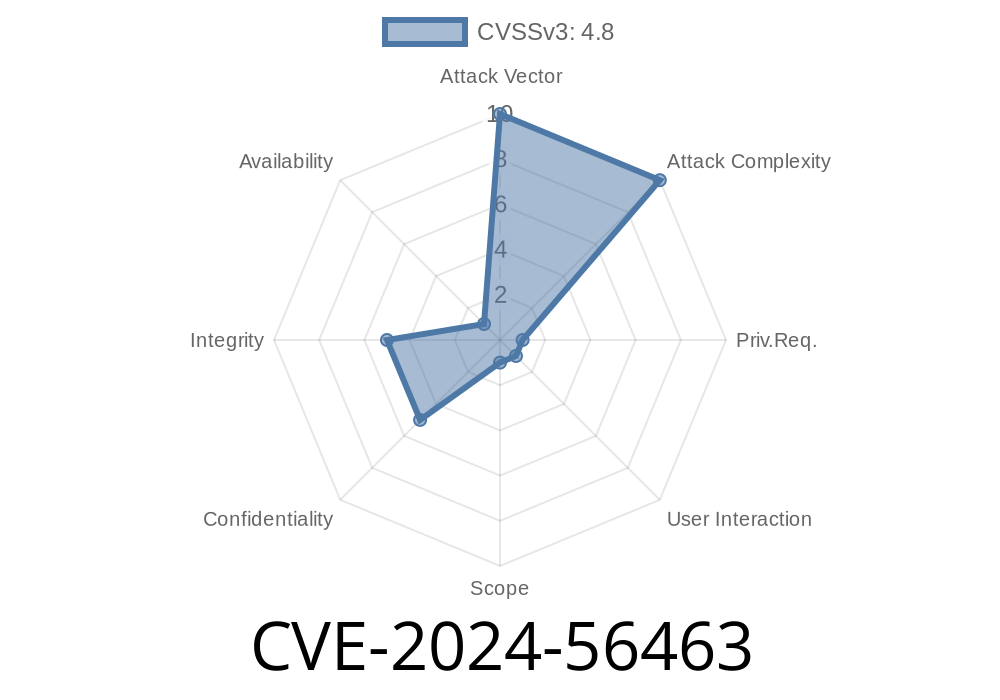In today's increasingly digital world, cybersecurity has become a top priority for individuals, organizations, and governments alike. With cyber-criminals launching sophisticated attacks at alarming rates, it is essential to stay aware of vulnerabilities to protect sensitive information and systems. One such vulnerability is the Cross-Site Scripting (XSS) vulnerability in IBM QRadar SIEM 7.5 (CVE-2024-56463), which poses a significant risk to users. In this post, we will discuss the vulnerability, its potential consequences, and how to mitigate the threat.
What is IBM QRadar SIEM 7.5?
IBM QRadar SIEM (Security Information and Event Management) is a widely used security solution that consolidates log sources and event data from various devices, endpoints, and applications. By analyzing the data, QRadar can detect security incidents and generate alerts, helping organizations to respond quickly to potential threats and comply with various regulations.
Understanding CVE-2024-56463: Cross-Site Scripting Vulnerability
The identified vulnerability, assigned as CVE-2024-56463, affects IBM QRadar SIEM 7.5. This XSS vulnerability allows an attacker with privileged access to embed arbitrary JavaScript code in the Web User Interface (UI), thus altering its intended functionality. Users who access the maliciously-modified page in a trusted session are exposed to potential credentials disclosure, which an attacker can use to perform unauthorized actions with the victim's privileges.
The following code snippet demonstrates an example of a Cross-Site Scripting payload
<script>alert('XSS Vulnerability: CVE-2024-56463')</script>
An attacker can inject this script into a vulnerable page, and when an unsuspecting user accesses the page, they will receive an alert stating the vulnerability.
Details of the discovered vulnerability can be found at
- IBM Security Bulletin
- NVD - CVE-2024-56463
The CVE details disclose that the vulnerability has been given a CVSS (Common Vulnerability Scoring System) score of 6.1, with a medium severity rating.
How to Mitigate the CVE-2024-56463 Vulnerability
To protect your organization against the XSS vulnerability in IBM QRadar SIEM 7.5, it is essential to mitigate the risk by following best practices and applying available security patches.
1. Upgrade to the newest version: IBM has released a security patch to address the CVE-2024-56463 vulnerability. Organizations using the vulnerable version of QRadar SIEM should install the latest version and recommended security patches immediately.
2. Implement secure coding principles: When developing applications, follow secure coding practices like OWASP Top Ten to reduce potential vulnerabilities. Specifically, sanitize and validate user inputs, use parameterized statements, and employ proper output encoding to prevent XSS attacks.
3. Configure Content Security Policy (CSP): Implementing a CSP header in your web applications can significantly reduce your XSS attack surface. A robust CSP configuration disallows the execution of arbitrary scripts from unauthorized sources.
4. Regular vulnerability scanning: Regularly scan your application and infrastructure for vulnerabilities using vulnerability scanning and penetration testing tools, and apply the necessary security updates to keep your systems secure.
5. User Awareness & Training: Train and educate users about potential cyber threats, including phishing scams and social engineering attacks, to minimize the risk of successful attacks.
By proactively addressing the CVE-2024-56463 vulnerability and adopting a comprehensive approach to cybersecurity, organizations can safeguard their sensitive data and minimize the risk of falling victim to cyber-attacks.
Timeline
Published on: 02/14/2025 17:15:16 UTC
Last modified on: 02/15/2025 01:13:41 UTC
